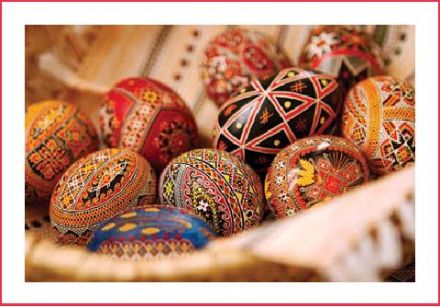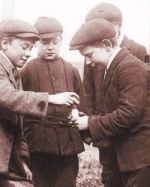 |
Were the original Easter eggs chocolate?
Origin, Life, Fertility and Renewal
An egg's shape is fascinating. The tradition of decorated eggs goes back to the furthest reaches of history, because since time immemorial the egg's shape has symbolized fertility, life and renewal. In the Kalevala, the sacred book of the ancient Finns, it is said that Iltamara, the mother of water, was sleeping on the bottom of the ocean that then covered the whole surface of the globe. One day, turning in her sleep, she caused her knee to break through the surface of the water, round like an island. The master of the air, fascinated by its shape, placed on it a golden egg.
Iltamara trembled at his touch and broke the shell: its pieces were scattered to create the world as it is today. The bottom of the shell became the firmament and was coloured by the blue reflections; the yolk became the sun, the white the moon, the light pieces of the shell the stars, and the dark parts clouds. Thus the world took shape.
Other sources say that the egg symbolizes the four elements of life: the shell represents the earth; the membrane, air; the white, water; and the yolk, fire.
In Japan, all the foods chosen during the month of September have some connection to the moon, to mark the semi-annual feast of Tsukimi. Half an egg is always placed into a small cup circled with blue, a symbol of the moon surrounded by clouds.
In the Middle Ages great egg processions were held, occasions to celebrate the season of renewal and rebirth as nature awoke from her long sleep.
In the 11th century a tradition began whereby the new year started on Easter Sunday, the feast of resurrection and spring. Eggs became a new year's gift, symbols and wishes of fertility. A century later the eggs were blessed by the church and even the king of France would distribute these symbols of resurrection in the church square at the end of Easter mass. In the 18th century, officiers de bouche, officials who oversaw the royal table, had to travel throughout the region around Paris to find the largest eggs. The king would then have them gilded and blessed before distributing them to members of the royal household.
Eggs also symbolize life in a charming tradition from Provence, in which a newborn is presented with an egg, salt and bread so that its life might be healthy and happy. In Chinese custom, nothing is as effective in bringing a newborn luck than numerous egg designs in the baby's cradle.
The Evolution of Painted Eggs
Though the egg was a cult object to the Persians, it is to Septimus Severus that we owe the transformation of eggs into gifts - thus the history of painted eggs goes all the way back to ancient Rome. Though emperor, Septimus Severus was not above visiting the imperial barnyard; imagine his surprise when a chicken laid a red egg early in the morning on the day of his son's birth. This amazing anomaly of nature unleashed a whole new tradition.
Easter eggs - because chickens don't observe Lent
A strong wave of piety ran through chicken farms from the 4th century onwards, leading to the custom of giving eggs on the first Sunday after the full moon following the spring equinox - a rather less spiritual way to celebrate Christ's resurrection throughout Christendom. Why? you may ask. Simply because the church forbade the consumption of eggs during the forty days of fasting that preceded Easter - but since chickens don't observe Lent, they continued to lay! Thus by Easter morning, people found themselves with a large quantity of eggs. It was necessary to share the surplus by giving them away. A basket full of fresh eggs is a nice gift - but when coloured and painted with figures and designs, they became true presents: beautifully arrayed and designed to give pleasure.
Every country and every era has had its particular styles. Traditions have not evolved in the same way from one region to the next, though one thing remains the same: on Easter morning eggs of varying colours are exchanged, whether among Egyptian Coptic Christians of the 10th to 12th centuries, or the inhabitants of Alsace in the 15th and 16th centuries.
In the year 1200, under England's King Edward I, the royal ledgers showed an expense of 18 pence for the purchase of 450 eggs that were decorated with gold leaf before being distributed to members of the royal household. The gold-covered eggs brought wealth to those who received them. This royal custom was still in evidence 500 years later when Louis XIV of France institutionalized it. His people were required to bring him the largest egg laid in the kingdom during Holy Week, while on Easter Sunday the king himself, surrounded by large baskets, would personally distribute gilded eggs to both his courtiers and menials.
Later on, eggs became used as currency and every year churchmen would go through the streets of Paris, baskets on their arms, to collect their ecclesiastical dues.
Greece
It is still customary to offer unshelled hard-cooked eggs, dyed red, to friends and family members during the Easter holidays.
Switzerland
Eggs were painted with bells and edelweiss and hung from tree branches.
Ukraine
Originally eggs were decorated with motifs representing wishes and prayers. For example, little suns were painted on to obtain fair weather, wheat stalks for a good harvest, and so on. Nowadays, they are mostly painted with geometric designs in a technique reminiscent of batik. One colour is applied at a time, from the lightest to the darkest, first coating the shell with wax and then removing the wax only from the part of the design that is to be coloured. Red, black, yellow and orange are favoured hues. The eggs are then cooked in the oven, where they become shiny and hard - true, though fragile, works of art.
Russia
Beginning in the Renaissance, the painted egg of the common people existed alongside the valuable jewelled egg. The craze for eggs adorned with precious stones, plated in silver or adorned with gold filigree reached its height with the creations of Fabergé during the latter days of the Czars.
France
In the 13th century, clerics and students, always underfed, would set off on Easter Sunday in search of Easter eggs hidden throughout Paris. Since eggs could be neither eaten nor sold during Lent, every region of France began creating egg-rich pastries that became associated with Easter:
- Alise pacaude in the Vendée region
- Miflette in Burgundy
- Fougasson in Auvergne, etc.
Asceticism also played a role in adding to the chapter of superstitions. It was said that eating nothing but an egg laid on Good Friday would keep away illness until the following Easter Sunday. To get all the luck they could on their side, people would crush the eggshells to a powder so that the devil and evil spirits would no longer have a surface to write their names on.
It is said that refusing an Easter egg is an even greater affront than a slap in the face.
An Easter egg containing two yolks is a sign of incredible luck and guarantees good fortune to the person receiving it.
An egg blessed at Easter will repel illness.
An Easter egg planted in a vineyard will protect the vines from thunder storms and hail.

In certain countries and in various regions such as Louisiana and UK, there exists an Easter game in which a person holds an egg firmly in his hand and knocks it against a neighbour's egg, trying not to break his own.
In France, a game is played in the village squares called "roulée" or "touquette." Though rules vary, the main idea of the game remains the same: whoever does not break his egg is the winner.

It was not until the 18th century in France that someone came up with the idea to empty out a fresh eggshell and fill it with chocolate. Then came moulds, decorations and many delicious traditions.
In France, when children hear the bells on Easter morning they set out into the yard to hunt for Easter eggs… or for chocolate chickens hiding in the shrubbery!
Here it's the bells that bring sweets to good children, hidden under their wide iron or bronze skirts, as they ring out their pride at having been blessed in Rome on this holy day. However they are not the only emissaries: in the Tyrol it's a chicken, in Switzerland a cuckoo, and in Anglo-Saxon countries, a rabbit.
The tradition of the chocolate bunny has had a long evolution, beginning with the ancient Teutons who firmly believed that at Easter it was the rabbits' turn to sit on eggs. The rabbit-Easter-chocolate associations derive from this popular tradition.

Photo above : pysanka, ukrainian eggs
Photo of the chocolate egg pyramide : "Galinette Star" from Lenôtre

-

 Recipes
Recipes
-

 Products
Products
-

 Entertaining
Entertaining
-

 Chefs
Chefs
-

 Hints & Tips
Hints & Tips
-

 Glossaries
Glossaries








